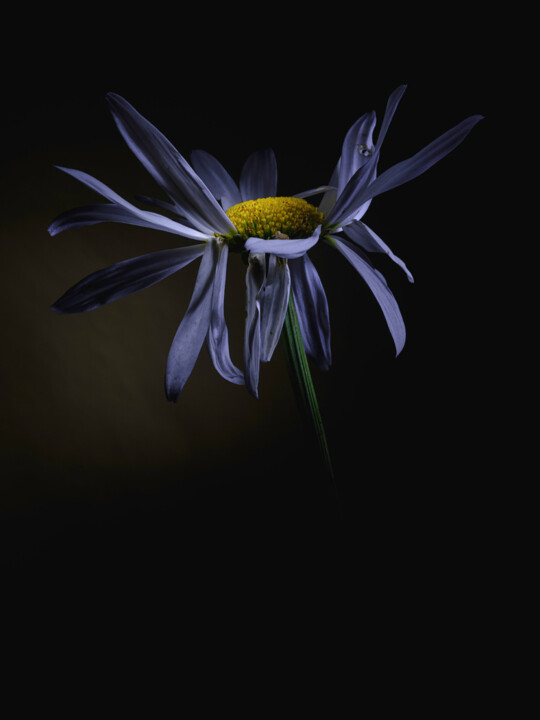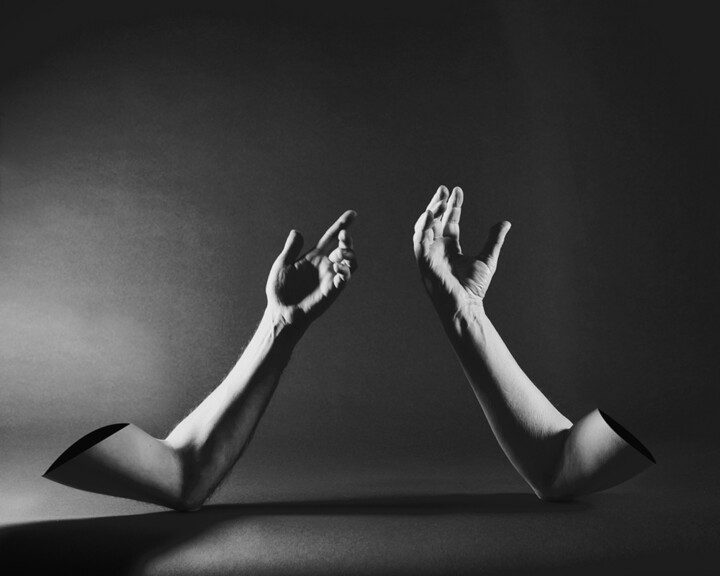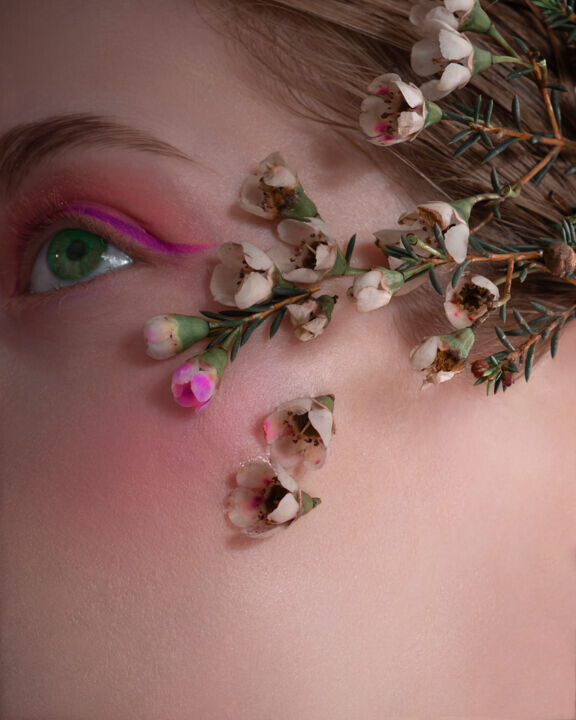 STILL LIFE N°2 (2021) Photography by Séverine Maigre (AERIN m.).
STILL LIFE N°2 (2021) Photography by Séverine Maigre (AERIN m.).
1. Another kind of vanitas...
A small table illuminated by soft light reminds us of the inexorable precariousness of our lives, harboring on its surface wilting flowers, skulls, and a few possessions of luxuries that will prove quite useless once we cross the threshold of the beyond grave. This description could be juxtaposed with a high, and almost indefinite, number of vanitas, still lifes with symbolic elements alluding to the theme of the transience of life, intended to serve as a memento mori, that is, a serious warning of the ephemeral condition of human existence, at least, on this earth. Perhaps, it is possible to be considered a kind of vanitas, reduced to its minimum terms and placed in a rather unusual portrait context, that kind of "stamp," decorated with a skull and a bone, that we can admire arranged on Frida Kahlo's forehead, precisely in her 1943 self-portrait, titled Thinking about death. This new interpretation of the aforementioned genre, now integrated into the frontal view of the painter's features, stems from an extremely tormented period of the artist, who put to the test by numerous illnesses and complications, felt like a condemned to death. In any case, in ancient Mexican culture, death also means rebirth to new life, so much so that the Frida of the aforementioned masterpiece surrounded herself with flourishing plants, symbols of eternity that will accompany her on her next long journey. Returning, however, to the concept of capital punishment, and abandoning painting for the photographic medium, the innovations of vanitas continue in the contemporary, through the work of Mat Collishaw, a British artist who specializes in the use of video and photography, who has created Last Meal on Death Row, a series of images depicting the last meal chosen by seven death row prisoners, which have been recreated in still life compositions, which, without referring to the typical skulls, offer a new interpretation and viewpoints on the aforementioned genre.
 BEAUTYGONE 2 (2023) Photography by Edgar Garces.
BEAUTYGONE 2 (2023) Photography by Edgar Garces.
 ETERNAL STILL LIFE... [ EXTRACTION 2 ] (2020)Photography by Cédric Zuwala.
ETERNAL STILL LIFE... [ EXTRACTION 2 ] (2020)Photography by Cédric Zuwala.
2. The explosion...
BOOOOM! This sound, which immediately makes us think of a violent explosion, is, overwhelmingly, associated with works of figurative arts, depicting dramatic and somewhat detailed scenes, or with masterpieces that take up the subject through the more concise language of comic strips. Wanting to illustrate the first example cited, I refer to George Grosz's Explosion (1917), which, by depicting an urban landscape of smashed, flaming houses, shattering windows, half-naked covers, shadowy faces, and hugging characters, pursued the intent of staging the horrors of World War I. The dramas of the latter event are internalized through the use of multiple perspectives and intense colors, which, by accentuating the feelings of instability and danger, bring us back to a clear interpretation of the futurist approach. Speaking instead of the world of comic books, it is impossible not to think of the well-known Explosion (1965-66) by Roy Lichtenstein, whose Pop language, beginning in 1962, was devoted to borrowing images of explosions from war comics in order to "transport" them into his most iconic paintings. Coming to the more contemporary world, the "explosive phenomenon," through the intervention of Ori Gersht, an Israeli fine arts photographer, has also landed, in an unpredictable way, in the still life genre, just as evidenced by his series of works which, titled Blow Up, portrays elaborate floral compositions, based on 19th century flower paintings, and especially those of Henri Fantin-Latour, which are captured by accurate shots, aimed at capturing at the moment they blow up. However, the explosion is not the only novelty brought by this type of still life, as its aftermath transforms flowers, the symbol of peace par excellence, into a kind of sacrificial lambs: victims of a brutal terror, which, unjustly, all too often lashes out at the most delicate, fragile, and unconscious forms of life.
 PHOTOGRAPHY JEANTURCO NUMBER 1589 (2022) Photography by Jean Turco.
PHOTOGRAPHY JEANTURCO NUMBER 1589 (2022) Photography by Jean Turco.
3. New materials...
Finally, I take you back to the image of one of the most classic floral still lifes ever: Flowers in a Wooden Vase by Jan Brueghel the Elder, a masterpiece from about 1606, aimed at fixing in painting a container in which a multitude of cut flowers were laid and ordered by size, so that at the bottom are placed the smallest specimens and at the top the largest ones. Although since the time of the Greeks the first artificial flowers had been devised, cleverly borrowed from oriental customs, generally the painters of the Flemish seventeenth century used real plants for models, consequently I wonder: what if modern plastic flowers entered the more classical still life genre? This curiosity is amply revealed to us by Richard Kuiper, a photographer who, inspired by the Dutch Golden Age, and in particular by the collections of paintings of the wealthy merchants of the time, who commissioned works from such masters as Pieter Claesz, Floris van Dijck, Frans Snyders, Adriaen Coorte, and Balthasar van der Ast, captures plastic still lifes, denouncing not only the changes in costume but also the wide spread of this harmful material to our environment. The analysis of photographic still lifes continues, involving the work of some of Artmajeur's artists, such as The Imaginati, Ordo Abkao and Sofia Zelenskaya.
 A SHOE AS A STILL LIFE WITH FRUITS (2023) Photography by The Imaginati.
A SHOE AS A STILL LIFE WITH FRUITS (2023) Photography by The Imaginati.
The Imaginati: A shoe as a still life with fruits
What is innovative about The Imaginati's photography? To explain it, I need Miró! The Spanish master made, precisely in 1937 and while he was in Paris, Still Life with Old Shoe, in which the isolated objects, depicted not to scale, find a spatial reference point in the back, irregular edge of the plane on which they rest, which can be read as an approximate horizon line. Regarding chromaticism, on the other hand, the color of the work appears somewhat acidic, highly saturated and dissonant, having the purpose of capturing, referring to the artist's own words, a deep and fascinating reality. In reality, however, such apocalyptic hues arise from the context of the Spanish Civil War, an event that is synthesized and internalized by the artist's strong feelings of anguish and fear, so much so that the painting is often compared to Picasso's restless Guernica. The 1937 work is one of the many examples of shoes represented "passively" within the still life genre, while in A shoe as a still life with fruits, on the other hand, the aforementioned object is distinguished by its "active" role, in that it does not merely appear for what it is, but also becomes a kind of container for fruit, used in the same way as a more common bowl. Perhaps, the fact that the shoe is somewhat worn out, and probably not very usable for its original function, justifies the artist's ecological choice not to get rid of the old one, to give it a new vital function. Finally, I quote The Imaginati's own statements that the photo represents a temporal medium: "A shoe as still life with fruit is an original artistic creation that combines a modern sneaker with fruit or vegetables to create a symbiotic composition, an alchemy between past and present."
 PRINCESS (2018) Photography by Ordo Abkao.
PRINCESS (2018) Photography by Ordo Abkao.
Ordo Abkao: Princess
The remains of a T-rex princess, or any other dinosaur specimen for that matter, appear as the sole and frontal protagonist of Abkao's ironic photography, capable of ascribing the highest noble titles to an animal that died even before the birth of man and, consequently, of these latest social "recognitions." A similar "prehistoric" humor can be found, this time in sculpture, in Maurizio Cattelan's Felix, a skeleton created for the MCA (Sydney), who, inspired by the popularity of the Tyrannosaurus rex exhibited at the Field Museum (Chicago), wanted to reinterpret its menacing and gigantic figure into a version of a more friendly and "affable" domestic cat, pursuing the intention of challenging the perception of the subject, questioning preset notions of artifact and exhibition. Regarding the name of the sculpture, however, it was inspired by the well-known cartoon character Felix the Cat, evoked in order to engage the younger audience in the contemporary museum narrative. Returning to the artist in Artmajeur, however, his vanitas, respecting the most faithful likeness of the predator, detaches itself from a purely perceptual intent, demonstrating, rather, how on the day of our demise every honorific title earned in life will be quite useless.
 SPRING (2021) Photography by Sofia Zelenskaya.
SPRING (2021) Photography by Sofia Zelenskaya.
Sofia Zelenskaya: Spring
Sofia Zelenskaya is a Russian photographer who specializes in the depiction of the female figure, so much so that her works, focused mainly on female themes, often investigated in the nude version, are characterized by a new and visionary light, almost revealing points of view still unknown to the human eye. In fact, the Spring photograph juxtaposes, in a somewhat unprecedented way, a female close-up with a floral portrait, merging two genres into a tale, which seems to narrate the affinity between the delicacy of the woman and that of a particular plant, which separates into two fragments at the very bottom of the model's cheekbone. A "similar" profile of a woman also appears in a well-known masterpiece of art history, which, once again, placed the female presence alongside the still life genre: I am talking about Balthus's Still Life with a Figure (1940), an oil painting dominated by a composition of still lifes arranged on a table, in which, on the far right, there is the presence of a young and enigmatic female figure, abruptly cut off at the right edge of the image so that only her head, hands and a sleeve of her dress are visible. Thus, although the work of the Polish master does not involve the physical "fusion" of woman and nature, it, like that of the artist from Artmajeur, provides us with a studied perspective of the female body, which is used to show and introduce, as a kind of valet, the peculiarities of flowers, fruit, etc.


 Olimpia Gaia Martinelli
Olimpia Gaia Martinelli